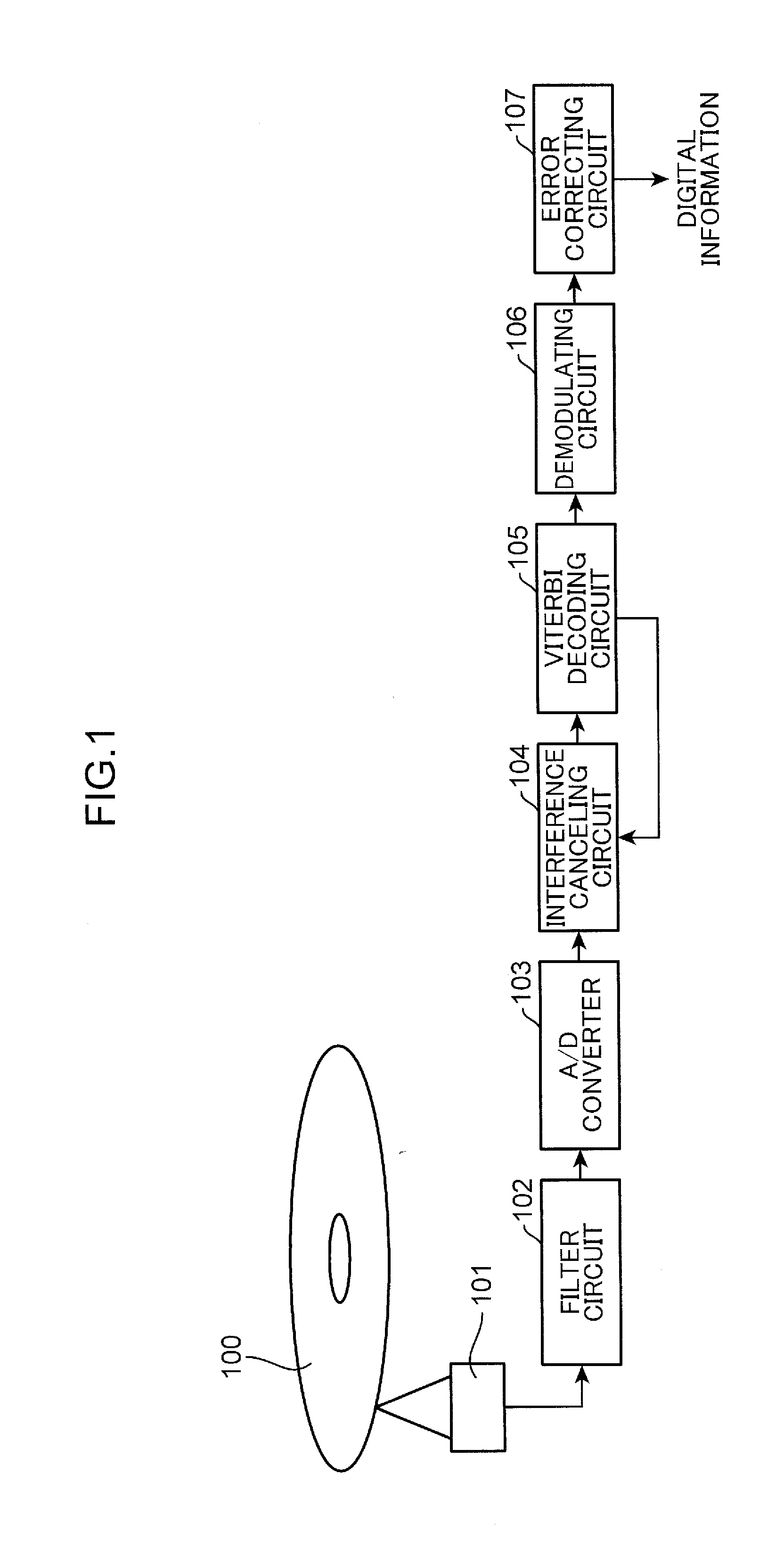Decoding device and decoding method
- Summary
- Abstract
- Description
- Claims
- Application Information
AI Technical Summary
Benefits of technology
Problems solved by technology
Method used
Image
Examples
first embodiment
[0068]FIG. 1 is a diagram showing a configuration of an optical disk device according to a first embodiment of the present invention. Moreover, FIG. 1 shows a configuration of a portion related to a processing system which reproduces digital information from an optical disk 100. The optical disk device shown in FIG. 1 comprises an optical pickup 101, a filter circuit 102, an A / D converter 103, an interference canceling circuit 104, a Viterbi decoding circuit 105, a demodulating circuit 106, and an error correcting circuit 107.
[0069]On the optical disk 100, a recording mark is formed on a track in accordance with a recorded code obtained by performing error correction encoding according to a predetermined error correction encoding system and modulation encoding according to a predetermined modulation system on digital information. A reproduction process for reproducing recorded digital information is performed by utilizing the fact that the amount of reflected light with respect to l...
second embodiment
[0110]FIG. 13 is a diagram showing a configuration of an optical communication device according to a second embodiment of the present invention. The optical communication device comprises a transmitter 1007, an optical fiber 1003, and a receiver 1008.
[0111]The transmitter 1007 which transmits transmission information comprises an error correction encoding circuit 1000, a modulating circuit 1001, and an optical modulating circuit 1002. The error correction encoding circuit 1000 performs error correction encoding on transmission information to be transmitted. The modulating circuit 1001 digitally modulates the transmission information subjected to error correction encoding using a modulation system such as ASK (amplitude shift keying) or PSK (phase shift keying), and outputs the digitally modulated transmission information as a digital code. The optical modulating circuit 1002 generates an optical signal waveform having intensity or a phase of light with a predetermined waveform modul...
third embodiment
[0125]First, before describing a decoding device and a decoding method according to a third embodiment of the present invention, problems found in conventional art will be described.
[0126]In recent years, due to higher density of optical disks, a shortest mark length that is a length of a shortest recording mark is approaching a limit of optical resolution and an increase in intersymbol interferences and degradation of SNRs (Signal Noise Rates) are becoming more noticeable. In consideration thereof, a PRML (Partial Response Maximum Likelihood) system is generally used as a signal processing method.
[0127]The PRML system is a technique that combines a partial response (PR) with maximum likelihood decoding (ML) and is a system which selects a most likely signal sequence from a reproduced waveform on the premise that a known intersymbol interference is to occur. Therefore, the PRML system is known for improved decoding performance as compared to conventional level judgment systems.
[0128...
PUM
 Login to View More
Login to View More Abstract
Description
Claims
Application Information
 Login to View More
Login to View More - R&D
- Intellectual Property
- Life Sciences
- Materials
- Tech Scout
- Unparalleled Data Quality
- Higher Quality Content
- 60% Fewer Hallucinations
Browse by: Latest US Patents, China's latest patents, Technical Efficacy Thesaurus, Application Domain, Technology Topic, Popular Technical Reports.
© 2025 PatSnap. All rights reserved.Legal|Privacy policy|Modern Slavery Act Transparency Statement|Sitemap|About US| Contact US: help@patsnap.com



